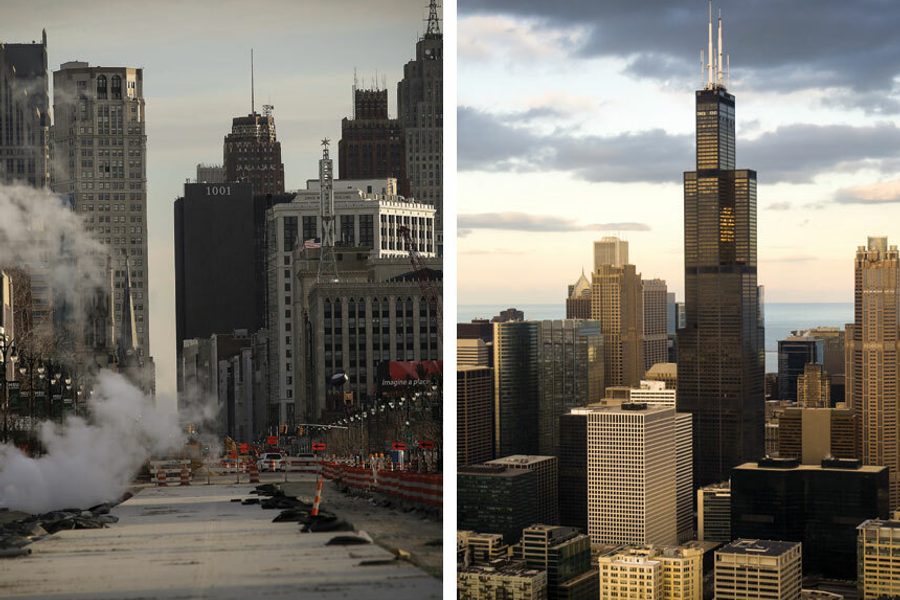Why Chicago Won’t Go Bankrupt—And Detroit Didn’t Have To
Detroit’s bankruptcy wasn’t inevitable. Neither is Chicago’s. But the austerity hawks don’t want you to know that.
Saqib Bhatti

When Detroit became the largest city in the history of the United States to file bankruptcy in 2013, a question quickly emerged: Which city would be next?
Because conventional wisdom held that bloated pensions had bankrupted Detroit, the conversation revolved around other cities with large pension shortfalls, such as New York, Philadelphia and Jacksonville, Florida. Anti-union politicians used the opportunity to hold up Detroit as a boogeyman. Bruce Rauner, then a Republican candidate for Illinois governor, ran a campaign ad in 2013 that said, “Detroit just declared bankruptcy, and if we don’t change direction, Illinois is next,” explicitly invoking the state’s unfunded pension liability as the reason (it should be noted that this claim was untrue, as federal law bars states from filing bankruptcy).
All of this uproar rested on a basic falsehood in the dominant public narrative around Detroit: that pensions played a key role in driving the city bankrupt. But those who studied the bankruptcy closely know that the reverse is true: The city filed bankruptcy so that it could cut pensions.
Detroit’s bankruptcy was not borne out of financial necessity and was not a foregone conclusion. It was a political decision made by state officials. Gov. Rick Snyder and the Michigan Legislature chose to push the distressed city over the edge in order to accomplish two otherwise difficult political goals: slashing pensions and regionalizing the Detroit Water and Sewerage Department. It was disaster capitalism at its finest.
Austerity hawks are now hoping to use the Detroit playbook in other cities to force the public to accept extreme measures to fix budget crises. And the bond markets seem to have finally settled on an answer to that question about which city will be the next Detroit: Chicago. Moody’s Investor Service, one of the three major credit rating agencies, just downgraded Chicago’s credit rating to junk level — the municipal equivalent of a subprime credit score, cautioning potential lenders that the city may not be able to pay them back — making it the lowest-rated major city in the country after Detroit.
Chicago is not an obvious choice. It remains the third largest city in the country, has a thriving downtown and is home to some of the largest and most profitable corporations and wealthiest people in the world. Chicago clearly has money, even though its distribution is wildly unequal.
But as was the case in Detroit, the talk of a Chicago bankruptcy has little to do with the city’s financial health and much to do with a broader political agenda to obliterate the social safety net and slash pensions. Even though there are numerous reasons why Chicago is not going bankrupt, the fact is that there has been a sustained effort by politicians like Mayor Rahm Emanuel to create a financial crisis and then use the threat of bankruptcy in order to usher in deep and painful cuts, just as the Right was able to do in Detroit.
Chicago is the test case for whether the Detroit playbook can be run in other, more prosperous cities. If it succeeds there, cities across the country will likely emulate this strategy to balance budgets on the backs of working-class communities while letting banks, big corporations and the rich off the hook.
The Detroit playbook
Most of us learn about bankruptcy through games like Monopoly or Wheel of Fortune, where being bankrupt is synonymous with being broke. But when it comes to municipalities, not only is bankruptcy a choice, it is a political choice. Elected officials decide whether to do it, when to do it and how to do it, and their primary reasons for doing it do not even have to be financial.
Municipal bankruptcy is also unique in other ways. In a corporate bankruptcy, for example, a company can be liquidated and all of its assets can be sold off to pay its creditors. However, as a matter of practicality, a city cannot be liquidated. Detroit is not Circuit City. If all its assets were sold off — streets, buses, police and fire stations — what would happen to the people who continued to live there post-bankruptcy? Because municipal bankruptcies are premised on the notion that cities should survive their bankruptcy and one day even thrive, the goal is not to obliterate a city in order to pay down its outstanding debt.
Under Chapter 9 of the United States Bankruptcy Code, municipalities may file bankruptcy if they are unable to pay their debts as they come due. In order to emerge from bankruptcy, they don’t need to be able to pay all of their outstanding debts right away, but rather to pay their bills on time. Just as a homeowner with a 30-year mortgage only needs enough money to make each monthly payment, cities similarly just need to be able to pay their bills, one bill at a time.
During Detroit’s bankruptcy proceedings, Emergency Manager Kevyn Orr, who had been appointed by Snyder to run the city during its fiscal crisis, repeatedly asserted that the city had $18 billion in outstanding debt, so as to imply that the city had to come up with $18 billion in savings to get out of bankruptcy. This was not true.
First of all, that $18 billion number itself was inflated using non-standard accounting assumptions and by including debt that did not actually belong to the city itself, such as the debt of the Detroit Water and Sewerage Department. But more importantly, the $18 billion figure was irrelevant for the purposes of Chapter 9 bankruptcy, since there was never any expectation that the city pay all of its long-term debts immediately. What mattered, according to an analysis by the think-tank Demos, was the $198 million cash flow shortfall that the city faced that fiscal year. Detroit’s expenses were $198 million more than its revenues, so it could not pay its bills as they came due.
The $198 million shortfall could have been addressed fairly easily — in part, simply by undoing state actions that had pushed Detroit into bad financial straits in the first place. For example, Detroit had taken a major financial hit over the course of 2011 and 2012, when Snyder and the Michigan Legislature decided to cut annual state revenue sharing with the city by $67 million. Restoring that funding would have filled one-third of the city’s shortfall. Second, there were state-imposed restrictions on the city’s ability to raise local taxes, dating back to the 1990s. Lifting those restrictions would have allowed the city to raise taxes and bring in new revenue.
Or the legislature could have passed a law requiring suburban employers to automatically deduct city income tax for reverse commuters who lived in Detroit. The city instead had to rely on reverse commuters to voluntarily pay their taxes. According to a study commissioned by the Mayor’s Office, in 2009 alone, Detroit lost $142 million as a result of this loophole. But instead, the $18 billion figure was held up to create a greater sense of urgency in order to justify drastic cuts at the expense of public employees and wrest control of the water department from the city.
Conservatives in Michigan had long been scapegoating Detroit’s pension obligations as the source of its fiscal problems, and Snyder began enacting policies to undermine pensions his first year in office. However, the Michigan Constitution, like that of many other states, protects government workers’ pensions from cuts — since pensions are, after all, deferred wages for work that has already been done. Federal bankruptcy law, however, does not protect pensioners when a city declares bankruptcy. Detroit was a test case for whether municipalities could get around their state constitutions by filing bankruptcy under Chapter 9. In 2013, during Detroit’s bankruptcy proceedings, a federal judge ruled that they can, because federal law trumps state law.
Then there was the Detroit Water and Sewerage Department (DWSD), a source of political power for the majority African-American city, which many white suburban residents had grown to resent. White suburban voters are an important constituency for Snyder, who needs them to make up for his low approval rating in Detroit, Michigan’s largest city.
The election of Coleman Young as Detroit’s first African-American mayor in 1973 accelerated white flight out of the city. Even though most of Detroit’s white families moved to the suburbs, they were still dependent on the city-run water department, which serves most of southeastern Michigan and 40 percent of the state’s population. This created a lot of tension. Whenever there were service problems or rate hikes, suburban residents blamed it on the mismanagement by what they believed to be corrupt and incompetent city officials. While corruption was a real problem in Detroit, including in the DWSD, these charges often fed off racial tensions.
Through bankruptcy, the state was finally able to take control of the water department out of Detroit’s hands and regionalize it. In one stroke, Snyder had achieved two long-sought political goals.
The next Detroit?
Politicians have been raising the specter of a Detroit-style bankruptcy in Chicago for a couple of years now— most recently in the mayoral runoff election this spring, when Sen. Mark Kirk commented that Chicago could end up like Detroit if Mayor Emanuel lost. But the threat never seemed credible to most people who were actually familiar with Chicago, because Chicago appears to be a fundamentally prosperous city. Then, in May, Moody’s Investor Service downgraded the credit ratings of both the City of Chicago and Chicago Public Schools to junk level. Suddenly, the threat seemed much more real.
The downgrades could force the city and the school district to hand over as much as $2.5 billion in early payments and penalties to banks on various financial deals. The city was forced to pay penalty interest rates on a $674 million bond offering, which will cost taxpayers an extra $70 million. The downgrades themselves were a direct response to an Illinois Supreme Court decision affirming the state constitution’s protection of government workers’ pensions, effectively prohibiting the state and local governments from slashing pensions to balance their budget. Mayor Rahm Emanuel would not be allowed to cut pensions and pay debts. Chicago seemed to be running out of options. Talk of a bankruptcy suddenly no longer seemed so farfetched.
Except that it is, because the political will is not there. Emanuel does not want his legacy to be that he bankrupted the third largest city in the country. Even though wealth and income are very unequally distributed across the city, Chicago still enjoys a healthy tax base and, unlike Detroit, has no statutory limits on its ability to raise local taxes (although it cannot implement a city income tax without state authorization). Chicago will not go bankrupt because the mayor will raise taxes if necessary to avoid that fate.
There is one other big reason why Chicago will not go bankrupt: It can’t. Under Illinois state law, municipalities are not allowed to file bankruptcy. Chapter 9 delineates the process for municipal bankruptcy, but it is up to each individual state whether to let cities use that process. Michigan does. Illinois, like 25 other states, does not.
As was the case in Detroit, politicians are invoking bankruptcy in Chicago to create public support for slashing pensions. Like Michigan’s, the Illinois Constitution also protects government workers’ pensions. There was a bill in the Illinois Legislature this session to allow municipal bankruptcies, and its chief proponents made no secret of the fact that their goal was to let cities use bankruptcy to get around the state constitution’s pension protections. Elected officials from smaller cities, such as Rockford Mayor Larry Morrissey, heralded the municipal bankruptcy bill as a godsend that would allow them to “set aside the unmanageable and unsustainable labor contracts and pension agreements with which local taxpayers have been saddled across the state.”
The bill was supported by Illinois Republican Gov. Bruce Rauner, who advocated the use of bankruptcy to help municipalities deal with their budget woes. Of course, he, too, was taking a page out of the Detroit playbook. He created a financial crisis for cities across the state by proposing a 50 percent reduction in municipalities’ share of state income tax revenue. Like state officials did to Detroit, Rauner inflicted financial hardship on cities and then dangled bankruptcy in front of them as the solution.
The municipal bankruptcy bill did not pass before the end of the session on May 31, but even the threat of such legislation can be a powerful tool for officials to strengthen their hand in contract negotiations with public sector unions and convince the broader public to accept an austerity agenda.
The predatory lending crisis no one talks about
Austerity hawks have done a great job of selling budget shortfalls as the result of reckless overspending by incompetent and corrupt government officials. As a result, the solution gets framed as a choice between cutting pensions or slashing the social safety net. Working-class communities lose either way, while the 1% remains untouched.
But the real problem with public budgets is that there is not enough revenue coming into public coffers. Since the Reagan Revolution, there has been a sustained effort to delegitimize government and suppress taxes. Tax rates for corporations and top income-earners have declined at precisely the moment that the United States has seen the most explosive population growth, leaving all levels of government unable to afford to pay for the basic services that communities need to function. As a result, government borrowing has skyrocketed.
While it is sound public policy to use debt to fund long-term capital projects, it is deeply problematic when governments are forced to borrow money to deal with revenue shortfalls. It is even more problematic when they are doing so as a result of a concerted effort to suppress taxes by the same banks and people they are borrowing from. Banks and the wealthy created a crisis by lobbying hard to suppress taxes, and then they use that crisis to enrich themselves — a page right out of the Detroit playbook.
When cities and states borrow money by issuing bonds, the lenders are typically high-wealth individuals, who purchase the bonds to get a tax break. It is a perverse system through which, rather than paying their fair share in taxes, the wealthy are instead able to lend that money to us, charge us interest for it, and then claim a further tax break on it.
The banks that underwrite municipal bonds also profit by selling cities addon products like interest rate swaps. As municipal debt exploded, from $361 billion in 1981 (about $940 billion in today’s dollars) to $3.7 trillion in 2012, banks started targeting cash-strapped cities with more and more of these add-ons, which had high costs and hidden risks, were overly complex and were often designed to fail. They were predatory finance deals, much like the predatory mortgages targeted at cashstrapped homeowners. Some of these practices were illegal, while others were merely unethical. The effect was that banks collected billions in fees from borrowing that was necessitated in the first place by their refusal to pay their fair share in taxes.
At the same time that this was happening, anti-government conservatives started sounding the alarm over rising government debt in order to make the case for privatizing services. This allowed many of the same corporations that had lobbied for lower taxes to then profit off the revenue crisis they had helped create by literally buying up public assets, such as tollways and parking meters, and then charging us to use them.
Because state and local governments did not have enough tax revenue coming in, they often opted for “pension holidays” to make ends meet, skipping payments to the pension fund. Over time, this created large unfunded pension liabilities. In effect, cities and states borrowed money from pensioners to make up for revenue shortfalls. Now austerity hawks are using these unfunded liabilities to argue for slashing pensions, even though it was their own anti-tax policies that caused the problem.
A progressive playbook
We need to flip the Detroit playbook on its head to create a new class of winners: working class communities. We must reject the paradigm in which Moody’s points a gun to our head and forces us to choose between closing schools and throwing seniors under the bus. We cannot allow austerity hawks to manufacture crises in order to push radically regressive agendas that balance the budgets on the backs of those who can least afford it.
We need to define the “austerity” problem as what it is — a lack of revenue caused by the refusal of Wall Street banks, big corporations and millionaires to pay their fair share in taxes— and put forth solutions to make them pay. This includes progressive revenue measures: We can pass a millionaires tax and a financial transactions tax, close corporate tax loopholes and end subsidies for profitable companies. It also includes policies to stop Wall Street from gouging taxpayers, like renegotiating predatory banking fees and toxic financial deals, and creating public banks to cut out Wall Street altogether.
We must reframe the choice for elected officials as one between the 99% and the 1%. Will Chicago’s Mayor Emanuel close another 50 schools to balance the Chicago Public Schools budget, or will he sue the banks that likely broke federal law by selling the school district predatory interest rate swaps that have cost hundreds of millions of dollars? Will Rauner cut state aid to cities in half and force them to slash essential public services, or will he fight for a millionaires tax? Whose side is he on?
A quick Google search shows that nearly every major city in America has been called “the next Detroit” at some point in the last two years. The Right plans to use the Detroit playbook across the country to force the general public to accept unconscionable cuts to public works while letting the true culprits off the hook. We need to expose the people and corporations who are profiting from the crises that they created, and force them to pay their fair share.
Saqib Bhatti is the Executive Director of the Action Center on Race & The Economy.









